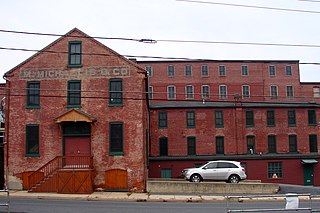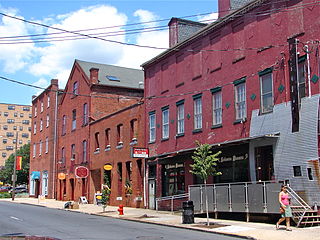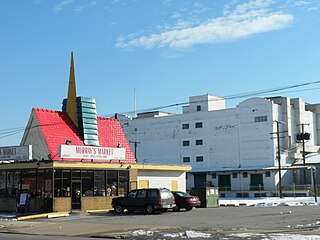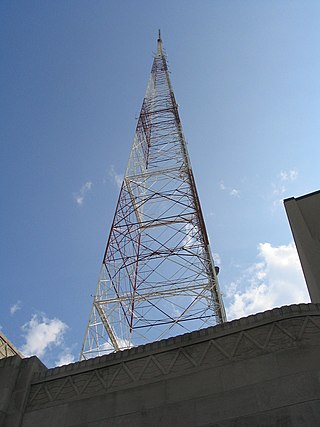
The Model Tobacco Factory is a historic industrial complex located in Richmond, Virginia. It was built beginning in 1938, and consists of ten contributing structures, including a prominent six-story rectangular factory building designed in the Art Deco style. The building was designed by the Chicago architecture firm of Schmidt, Garden and Erikson and is known for its Moderne "sky sign" that dominates the north end of the building.

The North Shippen–Tobacco Avenue Historic District is an historic, American cigar factory and tobacco warehouse complex and national historic district located in Lancaster, Lancaster County, Pennsylvania.

The Teller Brothers–Reed Tobacco Historic District is an historic, American cigar factory and tobacco warehouse complex and national historic district located in Lancaster, Lancaster County, Pennsylvania.

The North Charlotte Street Historic District is an historic, American, tobacco warehouse complex and national historic district that is located in Lancaster, Lancaster County, Pennsylvania.

The North Prince Street Historic District is an historic, American tobacco warehouse complex and national historic district located in Lancaster, Lancaster County, Pennsylvania.
Linthicum & Linthicum was an architectural firm in North Carolina. It was a partnership of Hill Carter Linthicum (1860–1919) who was a prolific architect, and H. Colvin Linthicum, his son.

The Danville Tobacco Warehouse and Residential District is a national historic district located at Danville, Virginia. The district includes 532 contributing buildings, 3 contributing sites, and 2 contributing structures in the city of Danville. The district reflects the late-19th century and early-20th development of Danville as a tobacco processing center and includes residential, commercial, and industrial buildings reflecting that growth. It also includes archaeological sites related to early Native American settlements in the area. Notable buildings include the American Tobacco's Harris Building, the Imperial Tobacco Company Building, Cabell Warehouse, Patton Storage Units, Crowell Motor Company, Municipal Power Station (1912), Riverside Cotton Mill #1 (1886), and a variety of "shotgun" houses and bungalow workers housing. Located in the district are the separately listed Danville Municipal Building and Danville Southern Railway Passenger Depot.

Atlantic Coast Line Railroad Commercial and Industrial Historic District is a national historic district located at Petersburg, Virginia. The district includes 15 contributing buildings, 1 contributing structure, and 1 contributing object located in a predominantly industrial and commercial section of Petersburg. The section housed some of Petersburg's important industries – tobacco and wholesale grocery and confectioner. Notable buildings include the Cameron Building, Export Leaf Tobacco Company (1913), H.P. Harrison Company (1912), Brown & Williamson complex, and Gibson Drive-in.

E. M. Todd Company, also known as Todd's Ham Building, is a historic factory building located in the Three Corners District of Richmond, Virginia. The original section was built in 1892 and expanded in 1919 and 1920. The expansion included five story smoke houses. It originally housed the Richmond Brewery, and was later acquired by the E. M. Todd Company a manufacturer of smoked ham and bacon. The E. M. Todd Company ceased operations at the plant in 1998.

Southern Stove Works, Manchester is a historic factory complex located in Richmond, Virginia that replaced the company's original factory. The complex includes two contributing prefabricated steel frame buildings built in 1920. The west building contains the original two-story office building that has been connected by one-story infill to the long one-story warehouse building that contained the pressing and mounting departments and a three-part warehouse. The office is a five-by-three-bay, two-story, building measuring 40 by 80 feet and brick curtain walls. The east building today consists of the foundry with attached original washrooms and office, charging room, and an expanded mill room.

The Carver Industrial Historic District is a national historic district located at Carver, Richmond, Virginia. The district encompasses 13 contributing buildings located west of downtown Richmond. The industrial area developed between 1890 and 1930, along the tracks of the Richmond, Fredericksburg and Potomac Railroad. The buildings are in a variety of popular 19th-century and early 20th century architectural styles including Queen Anne and Romanesque.

The Scott's Addition Historic District is a national historic district located in Richmond, Virginia.

Southern Biscuit Company, also known as Interbake Foods, Inc. and Famous Foods of Virginia (FFV), is a historic factory building located in Richmond, Virginia. The original section was built in 1927, and is a six-story, reinforced concrete building. It was subsequently expanded four times through 1951. The building features a water tower and distinctive roof-top sign. The sign has three rows of letters spelling "HOME OF", "FFV", and "COOKIES AND CRACKERS". The facility closed in 2006.

Crompton-Shenandoah Plant, also known as The Mill at South River, is a historic textile factory complex located at Waynesboro, Virginia. The complex includes 11 contributing buildings and 8 contributing structures involved in the dyeing and finishing of the gray corduroy and velveteen goods. The historic buildings and structures were built beginning in 1926 through 1948. The complex includes two plant buildings, a machine shop/supply storage building, a former enameling plant, a boiler house, a water softener building, a chemical storage building, a lab, a gate house/personnel office, an office building and a retail store. The factory closed in the 1980s along with most Crompton Corporation plants.

H. Lauter Company Complex, also known as J. Solotken Company, Lauter Lofts, and Harding Street Lofts, is a historic factory complex located at Indianapolis, Indiana. It was built between 1894 and 1912, and includes the South Factory, the North Factory, and the Office Building. The factory buildings are in the Italianate and the office building is in the Classical Revival style. The North Factory is a four-story brick building with a raised full basement constructed sometime between 1908 and 1912. The Office Building is a two-story brick building constructed between 1899 and 1908 and has a truncated hipped roof. The four-story, U-shaped core of the South Factory was built in two phases; the eastern portion between 1894 and 1898 and the western portion in 1899. The H. Lauter Company furniture manufacturer began in 1894 and they continued to operate at the location until 1936. The buildings have been converted to condominiums and apartments.

Woods–Evertz Stove Company Historic District, also known as General Wesco Stove Company, is a historic industrial complex and national historic district located at Springfield, Greene County, Missouri. The district encompasses six contributing buildings associated with a large cast iron stove manufacturer. The district developed between about 1904 and 1953, and all six buildings are in a simple industrial, factory style, with minimal architectural embellishment and have flat, low-pitch and gabled roofs.

The American Tobacco Company, South Richmond Complex Historic District encompasses a complex of tobacco storage, processing, and research facilities at 400-800 Jefferson Davis Highway in Richmond, Virginia. Included in the 16-acre (6.5 ha) site are four large warehouses, processing buildings including a stemmery and a re-drying plant, and ancillary buildings and structures, including the American Tobacco Company's 1939 research laboratory. The complex exhibits a historical range of trends in the processing and storage of tobacco.

The Blair Tobacco Storage Warehouse Complex Historic District encompasses a complex of tobacco storage and processing facilities at 2601 Maury Street in Richmond, Virginia. Included in the 26-acre (11 ha) site are 26 large warehouses, and a number of ancillary buildings. The complex exhibits a historical range of trends in the processing and storage of tobacco, dating from its inception in 1939 into the 1980s. The Blair Storage Company was founded in 1939 by Joseph Blair, the son of a dry goods dealer, who had diversified into the transport of tobacco and other goods before opening the storage facility.

The Philip Morris Blended Leaf Complex Historic District encompasses a complex of tobacco storage and processing facilities at 2301 Maury Street in Richmond, Virginia. Included in the 12-acre (4.9 ha) site are a series of warehouses and cigarette-making factories developed beginning in the 1950s. Philip Morris USA built this complex in part to capitalize on advances in machinery that greatly increased the production speed of cigarettes.

The American Tobacco Company Warehouses Complex is a pair of brick warehouses built around 1900 in Madison, Wisconsin. They are now the two most intact remnants of Madison's tobacco industry, and were added to the National Register of Historic Places in 2003.























